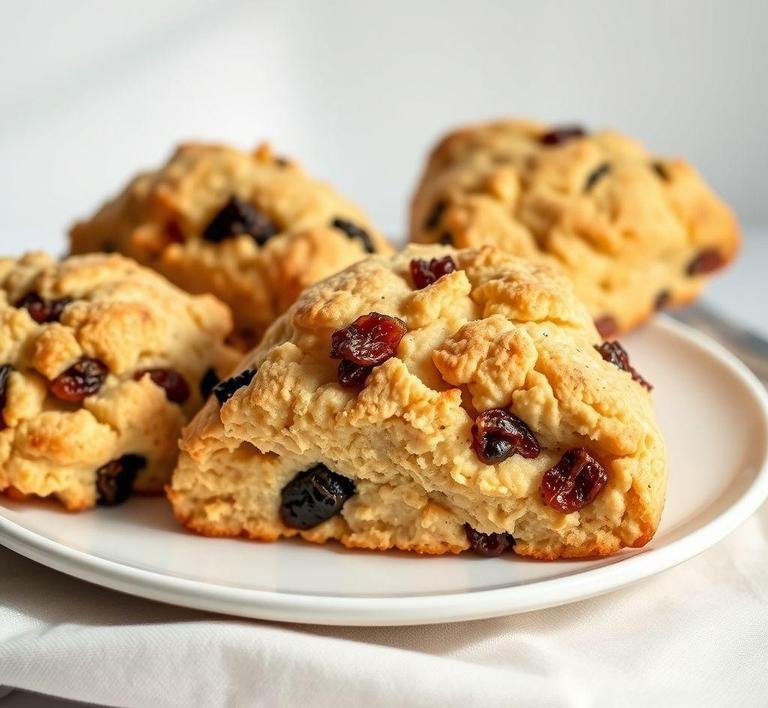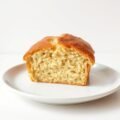Let me set the scene.
It’s a Sunday morning. The kind where the world feels slower, softer. where you’re not racing a clock but moving with the rhythm of your own breath. I reach for the flour, the butter and suddenly I’m transported. That’s the magic of Nigella Lawson’s fruit scones. They’re more than just a baked good. they’re a moment, a memory, a warm corner of British tradition made effortlessly elegant by Nigella’s signature touch.
Now, I don’t say this lightly: there’s something deeply nostalgic about scones. My first brush with them wasn’t actually in the UK. It was in my grandmother’s kitchen in upstate New York, oddly enough, where she used to call them “biscuits with a British accent”. Her version was good-dense, slightly crumbly-but it wasn’t until I tried Nigella’s fruit scones that I realized how light and whispery a scone could be. Not dry. Not cakey. But gently rising, just enough sweetness and those little nuggets of dried fruit in every bite like edible treasure.
Nigella’s take is pure comfort. She doesn’t fuss. Her recipes, much like her voice, soothe you into believing you’ve always known how to do this. You haven’t but she makes you feel like you have. These fruit scones? They’re everything you want with a cup of tea and a slathering of clotted cream.
Nigella Fruit Scones Recipe
Ingredients Needed

Here’s where the magic begins. not with some obscure culinary alchemy but with simple ingredients you probably already have tucked away.
- 500g self-raising flour – You’ll want it sifted, light as air.
- 2 teaspoons baking powder. Just enough lift, no drama.
- 100g cold unsalted butter – Cubed. From the fridge. No softening nonsense.
- 75g caster sugar – The fine stuff, so it blends in without a fuss.
- 100g sultanas or raisins. I’ve tried both; raisins are more nostalgic for me.
- 2 large eggs – Ideally room temp. That golden yolk makes a difference.
- 200ml milk – Full-fat if you ask me. Nigella doesn’t skimp and neither do I.
- Extra flour for dusting
- Extra milk or egg for glazing. Optional but that glossy top? Worth it.
I’ll admit: the first time I made these, I didn’t have self-raising flour and I tried to DIY it with plain flour and baking powder. It was fine but not magical. Trust me on this-get the self-raising.
Equipment Needed
No high-tech wizardry here. That’s part of the charm.
- Large mixing bowl – Something that feels like home in your hands.
- Pastry cutter or your fingers. I use my hands. There’s something grounding about it.
- Measuring scale or cups. I prefer a scale. It feels more precise, more European.
- Rolling pin – Or a wine bottle in a pinch (I’ve been there).
- Round cutter – 5cm or so. I’ve used a whiskey glass when desperate.
- Baking tray – Lined with parchment paper for easy cleanup.
- Pastry brush – For that golden glaze.
- Wire rack – Because warm scones steam if you trap them on the tray. Let them breathe.
Instructions To Make Nigella Lawson’s Fruit Scones
I always start by lighting a candle in the kitchen. No idea why-it just sets the mood. Then I put on a playlist (lots of Norah Jones and Fleetwood Mac) and dive in.
Step 1: Preheat And Prepare
Heat your oven to 220°C (200°C fan) / 425°F / Gas mark 7. Line your baking tray. Take a breath. You’re about to make something beautiful.
Step 2: Mix Dry Ingredients
In a large bowl, sift together the flour and baking powder. Then toss in the sugar and the cold butter. This is the point where your hands get involved. Rub the butter into the flour until it resembles breadcrumbs. Don’t overwork it-keep things light. Think sandy beach, not clay sculpture.
Step 3: Add Fruit
Now stir in your raisins or sultanas. They bring the scones alive-chewy, sweet surprises in every bite.
Step 4: Bring It Together
Crack your eggs into a measuring jug and top up with the milk to reach 300ml total liquid. Beat lightly, then slowly mix it into the dry ingredients. I use a butter knife to mix. it cuts through the flour gently. You want a soft dough but not sticky.
Step 5: Roll And Cut
Lightly flour your surface and pat out the dough. About 3cm thick is perfect. Don’t roll it too thin; this isn’t pizza dough. Use your cutter to stamp out rounds. Don’t twist the cutter. it seals the edges and stops the scones from rising. Learned that one the hard way.
Step 6: Bake
Place them on your tray, spaced just slightly apart. Brush with milk or egg for a golden top. Bake for 12-15 minutes until they’ve risen, golden and smell like heaven.
Step 7: Cool… A Little
Transfer to a wire rack. But let’s be honest. I always eat one warm, split open with a little butter melting into it. That first bite? Unbeatable.
What I Learnt
You know what surprised me? How forgiving this recipe is. You’d think scones were high-maintenance-so many people are terrified of them. But Nigella’s method is gentle. And when I made them, I realized something: baking isn’t about perfection. It’s about rhythm, about feel.
I also learned that the way your kitchen smells when these are baking? That’s memory-making stuff. The smell of butter and fruit, of sweet warmth and golden crust. My partner wandered in halfway through the bake, eyes half-closed like a cartoon character floating toward a pie on a windowsill. That’s the power of these scones.
And most of all, I learned to slow down. To enjoy the process. To not panic if the dough is a bit sticky or the scones aren’t perfectly round. Because when they come out of the oven and you take that first bite, all of that melts away.
FAQs
Can I Use Frozen Fruit For Nigella’s Fruit Scones?
Yes, you totally can! I’ve done it before when I had frozen mixed berries on hand. Just make sure you don’t thaw them completely before adding them to the dough, or they’ll end up a bit soggy. I usually fold them in straight from the freezer and everything turns out perfectly. You’ll get that lovely burst of fruit without the mess!
How Can I Make My Fruit Scones Fluffier, Like Nigella’s?
Ah, the fluff factor! Nigella’s recipe is pretty foolproof, but I’ve found that making sure you don’t overwork the dough is key. Also, don’t skip on sifting the dry ingredients-it makes a huge difference in the texture. I like to gently press the dough together and not knead it too much; just enough to bring it all together. You’ll get those light, airy layers in the scones that make them irresistible.
What Should I Serve With Nigella’s Fruit Scones?
Oh, this is where the fun begins! You can’t go wrong with a dollop of clotted cream and strawberry jam-classic, and it gives you that lovely contrast between the sweet fruit scones and the creamy toppings. I’ve also been known to drizzle a little honey on mine or serve them with a pot of fresh, lightly brewed tea. It feels like you’re in a cozy little tearoom in England!


